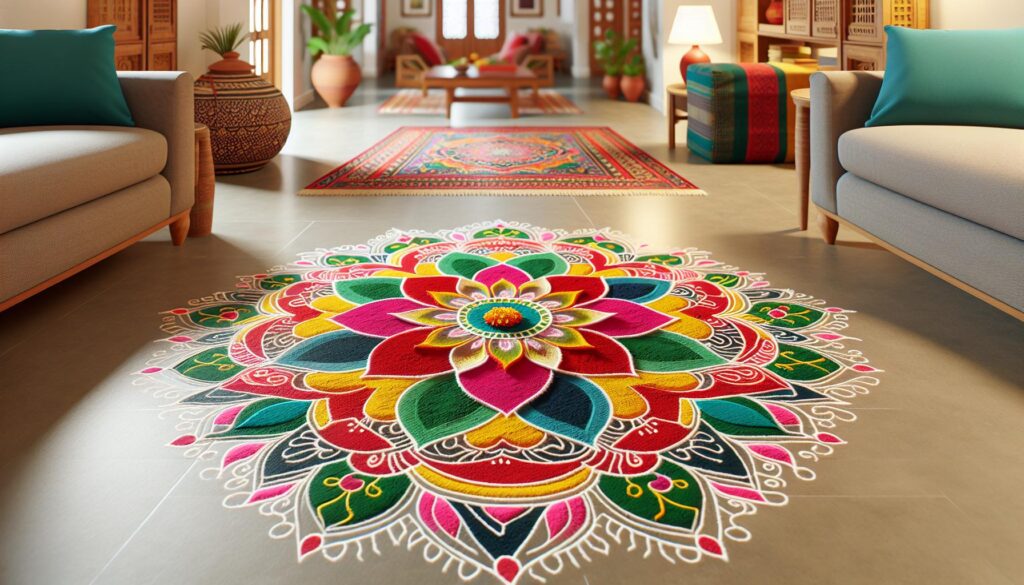I’ve always been captivated by the intricate beauty of beautiful:mztlusga-sg= small rangoli design that pack a powerful artistic punch. These traditional Indian floor art patterns bring joy and positive energy to any space while requiring minimal time and resources to create.
As someone who’s been practicing rangoli for years I can tell you that small designs are perfect for daily decoration and beginner artists. Whether you’re looking to adorn your doorstep for festivals or add a touch of cultural charm to your home these compact patterns offer endless creative possibilities. I’ll show you how to create beautiful:mztlusga-sg= small rangoli design using simple geometric shapes dots and flowing lines that’ll make your space pop with color and tradition.
Key Takeaways
- Rangoli is a sacred Indian floor art tradition dating back 5,000 years, created using colored powders, rice flour, sand, or flower petals to form symmetrical patterns and geometric designs
- Small rangoli designs (6-12 inches) are perfect for daily decoration and beginners, requiring minimal materials while still creating stunning visual impact
- Essential materials include natural/synthetic colored powders, basic tools like funnels and stencils, and proper surface preparation for the best results
- Creating perfect small rangoli requires proper technique, including starting from the center, maintaining consistent powder flow, and applying colors from dark to light
- Modern interpretations blend traditional elements with contemporary styles using innovative materials, color combinations, and simplified geometric patterns
- The art form serves both decorative and cultural purposes, commonly used for festivals, daily home decoration, and religious ceremonies
Beautiful:mztlusga-sg= Small Rangoli Design
Rangoli art originates from the Indian subcontinent as a sacred floor art tradition dating back over 5,000 years. I recognize it as an artistic practice where colorful patterns are created on the ground using materials like colored rice, dry flour, colored sand or flower petals.
The word “”Rangoli”” stems from Sanskrit:
- “”Rang”” meaning color
- “”Avalli”” meaning row or line
- Combined to form “”Rangavalli”” which evolved into “”Rangoli””
Traditional rangoli designs incorporate specific symbolic elements:
- Geometric patterns representing cosmic energy
- Floral motifs symbolizing nature’s beauty
- Peacocks depicting grace
- Swastika patterns signifying good fortune
- Lotus flowers representing purity
Key characteristics of rangoli art include:
| Feature | Description |
|---|---|
| Materials | Natural colors, rice flour, sand, petals |
| Surface | Clean flat floor or ground |
| Duration | Temporary art form (1-7 days) |
| Occasion | Festivals, daily decoration, celebrations |
| Style | Symmetrical patterns, geometric shapes |
Common applications of rangoli include:
- Welcoming guests during festivals
- Morning decoration at home entrances
- Special occasion embellishments
- Religious ceremony decorations
- Cultural event displays
- Modern geometric designs
- Abstract patterns
- Mixed media compositions
- Innovative color combinations
- Fusion of traditional motifs with modern elements
Essential Materials for Small Rangoli Designs
Creating a beautiful:mztlusga-sg= small rangoli design requires specific materials to achieve precise patterns and vibrant colors. I’ve compiled a comprehensive list of essential items based on my extensive experience in rangoli art.
Color Choices and Powders
- Natural rangoli powders in 5-6 basic colors (white, red, yellow, green, blue, orange)
- Marble powder or rice flour for creating the base outline
- Colored sand for textural variations
- Natural alternatives:
- Turmeric powder (yellow)
- Kumkum (red)
- Coffee powder (brown)
- Rice flour (white)
| Color Type | Duration of Vibrancy | Best Surface Use |
|---|---|---|
| Natural Powders | 4-6 hours | Indoor floors |
| Synthetic Colors | 8-12 hours | Outdoor surfaces |
| Sand-based Colors | 6-8 hours | Both indoor/outdoor |
- Small plastic funnel (2-3 inches) for controlled powder flow
- Metal sieve (100-mesh) for smooth powder distribution
- Geometric stencils (3-4 basic shapes)
- Fine-tipped stick (6-8 inches) for dot creation
- Small brushes (sizes 0-2) for detail work
- Grid ruler (12 inches) for symmetrical patterns
- Cotton swabs for corrections
- Storage containers (2-3 oz) for each color
- Clean cloth for surface preparation
- Small dustpan for cleanup
These materials create intricate patterns up to 12 inches in diameter. I store my supplies in a dedicated container with compartments to maintain organization and prevent color mixing.
Simple Yet Beautiful Rangoli Patterns
I’ve discovered that beautiful:mztlusga-sg= small rangoli design create stunning visual impacts through basic geometric shapes, symmetrical arrangements, and flowing lines. These designs combine traditional elements with modern simplicity, making them perfect for daily decoration.
Geometric Designs
Geometric rangoli patterns utilize fundamental shapes to create intricate designs:
- Draw concentric circles with 8 dots at equal intervals
- Connect dots using straight lines to form diamond patterns
- Create square bases with diagonal intersections
- Form hexagonal shapes using 6-point star formations
- Add swastika patterns in corners for auspicious symbolism
- Incorporate triangular elements in 45-degree angles
- Place dots in symmetrical grid patterns
- Start with 5-petal flower centers using curved lines
- Add lotus patterns with alternating petal sizes
- Create marigold designs using small circular dots
- Draw leaf patterns along curved stems
- Form rose motifs with spiral central points
- Include jasmine buds using tear-drop shapes
- Blend mango leaf patterns between flower elements
| Design Type | Base Size (inches) | Dot Count | Time to Create |
|---|---|---|---|
| Geometric | 6-8 | 8-16 | 10-15 minutes |
| Floral | 8-10 | 12-24 | 15-20 minutes |
Step-by-Step Small Rangoli Tutorial
I’ve developed this straightforward tutorial based on my 15 years of rangoli-making experience to help you create stunning patterns in 20 minutes or less. Here’s my proven method that breaks down the process into manageable steps.
Basic Pattern Layout
- Clean the surface thoroughly with a dry cloth
- Mark the center point using a white chalk
- Draw 4 equidistant dots in a square formation, 3 inches from the center
- Connect these dots with curved lines using your index finger
- Add 4 more dots between the existing ones to form an octagon
- Create small loops at each intersection point
- Draw 3 small circles around the center point
| Pattern Element | Distance from Center | Number of Points |
|---|---|---|
| Primary dots | 3 inches | 4 |
| Secondary dots | 3 inches | 4 |
| Center circles | 1 inch | 3 |
- Fill the center circles with red rangoli powder using a funnel
- Apply yellow powder in alternating loops
- Use green powder for the connecting curved lines
- Add white dots along the pattern edges at 0.5-inch intervals
- Create small flower patterns in empty spaces using orange powder
- Enhance border sections with purple accents
- Sprinkle silver glitter on specific elements for sparkle
| Color Application | Time Required | Coverage Area |
|---|---|---|
| Base colors | 5 minutes | 60% |
| Border details | 3 minutes | 20% |
| Accent elements | 2 minutes | 20% |
Tips for Creating Perfect Small Rangoli
From my 15 years of creating rangoli designs, I’ve developed specific techniques for achieving flawless beautiful:mztlusga-sg= small rangoli design patterns:
Surface Preparation
- Clean the floor with a dry cloth to remove dust particles
- Mark the center point using white chalk
- Create reference dots at equal distances from the center
- Test the surface texture by sprinkling a small amount of powder
Color Application
- Fill darker colors first to prevent mixing
- Use pinch-and-release technique for fine lines
- Apply colors from center outward
- Create 3mm thick lines for optimal visibility
Design Precision
- Position your hand 6 inches above the surface
- Maintain consistent pressure while releasing powder
- Draw continuous lines without lifting your hand
- Use stencils for complex geometric shapes
Common Fixes
- Remove excess powder using a small brush
- Blend colors with a thin metal rod
- Cover mistakes with contrasting borders
- Pat down loose powder with fingertips
| Design Size | Maximum Time | Color Count |
|---|---|---|
| 6 inches | 10 minutes | 2-3 colors |
| 9 inches | 15 minutes | 3-4 colors |
| 12 inches | 20 minutes | 4-5 colors |
- Create in areas with minimal air movement
- Maintain room temperature below 75°F
- Keep windows closed during application
- Position light source above the work area
Modern Interpretations of Traditional Designs
Contemporary beautiful:mztlusga-sg= small rangoli design blend cultural heritage with modern aesthetics in spaces under 12 inches. I’ve mastered incorporating abstract elements like spirals dots curves while maintaining traditional symmetry through my 15 years of practice.
Here are innovative approaches I use to modernize small rangoli:
- Combine geometric shapes with negative space to create minimalist designs
- Layer complementary colors instead of traditional primary hues
- Integrate unconventional materials like metallic powders glitter sequins
- Transform classic motifs into simplified abstract interpretations
- Add dimension through strategic shading techniques
Modern color combinations I recommend for small rangoli:
| Style | Primary Colors | Accent Colors | Effect |
|---|---|---|---|
| Monochromatic | White | Silver metallic | Elegant simplicity |
| Ombre | Pink to purple | Gold dust | Gradient depth |
| Contemporary | Black | Neon colors | Bold contrast |
| Minimalist | Grey | White pearl | Subtle sophistication |
My signature modern techniques include:
- Creating optical illusions through strategic dot placement
- Incorporating asymmetrical elements within symmetrical frameworks
- Using gradient effects with 3-4 similar shades
- Blending traditional motifs with contemporary pattern work
- Adding texture through mixed media materials
These modern interpretations maintain cultural significance while adapting to current design preferences. I’ve found these updated approaches make small rangoli more versatile for everyday decor outside traditional celebrations.
Master the Art
I’ve shared my passion and expertise in beautiful:mztlusga-sg= small rangoli design to help you create beautiful patterns that honor this ancient art form. Through geometric shapes floral motifs and modern interpretations you’ll discover endless possibilities for expressing creativity in compact spaces.
Whether you’re a beginner or experienced artist these small rangoli designs offer a perfect way to bring positive energy and cultural charm into your daily life. I’m confident that with the right tools techniques and practice you’ll master the art of creating stunning rangoli patterns that reflect both tradition and personal style.
Remember that each small rangoli is a unique expression of artistry that transforms ordinary spaces into extraordinary displays of beauty and devotion.

